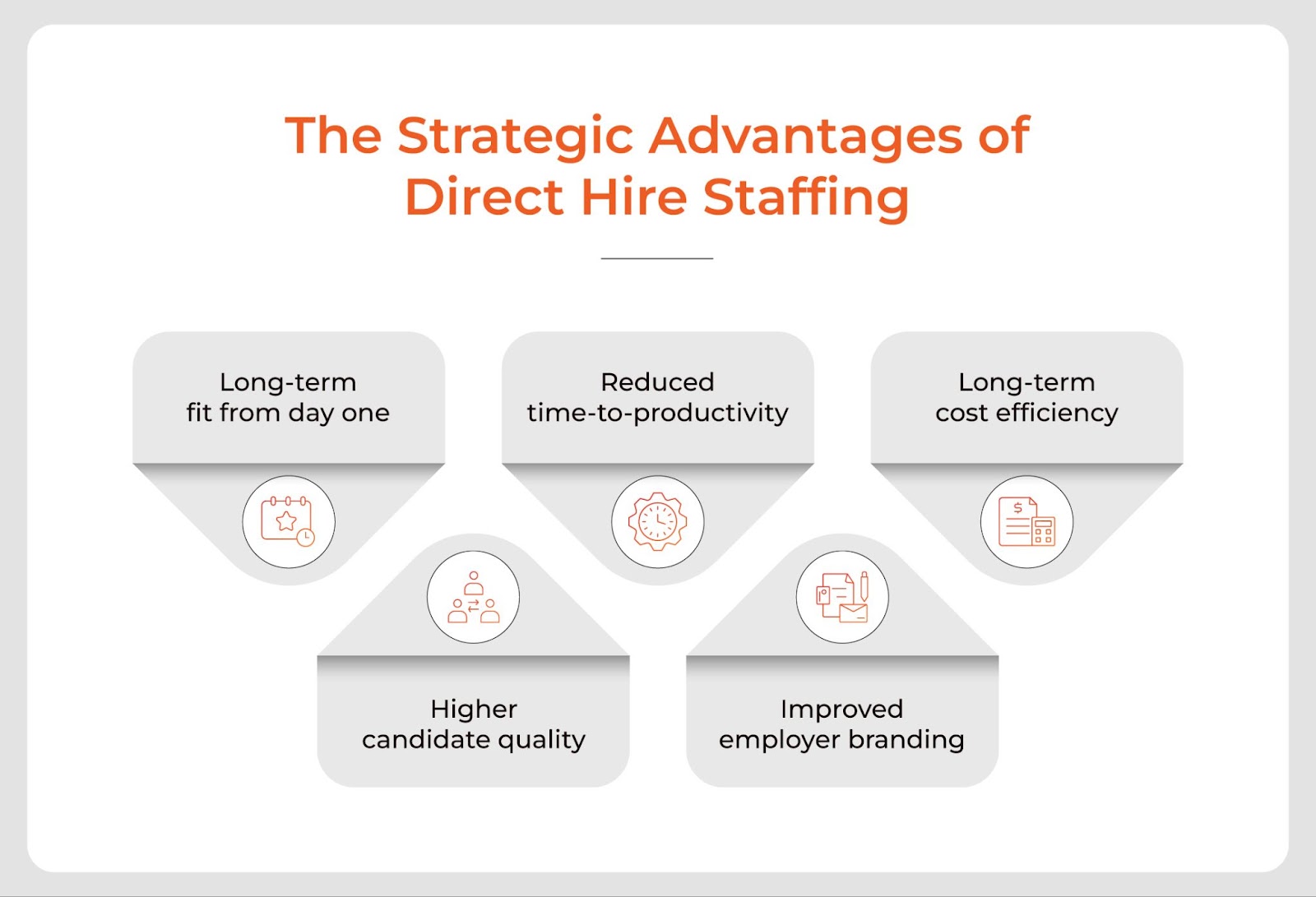Every role deserves the right hire, but not every hire needs the same approach.
Direct hire staffing is built for roles where long-term alignment with organizational goals matters. From mid-level specialists to senior leaders, it’s a model that prioritizes retention, cultural fit, and long-term value from day one.
Instead of cycling through short-term fixes, companies use direct hire recruitment to build stability into their teams, with full-time candidates placed directly on the company’s payroll.
It’s a strategic investment, but like any strategy, it comes with both pros and cons.
The Strategic Advantages of Direct Hire Staffing

1. Long-term fit from day one
Direct hire recruitment focuses on finding candidates who are not only qualified but also aligned with your company’s mission, values, and future plans. These aren’t short-term fixes. They’re high-retention, high-impact hires. When employees are brought in with long-term intent, their ramp-up and engagement trajectory tends to be stronger and faster.
2. Higher candidate quality
Let’s be honest: the best candidates aren’t applying on job boards at all. They’re being selectively courted, and they often consider only long-term roles that offer growth. That’s where direct hire staffing shines. Experienced staffing partners like SPECTRAFORCE tap into passive talent networks and pre-qualified pipelines that internal teams often don’t have the tools or the time to access.
3. Reduced time-to-productivity
Direct hire staffing accelerates time-to-productivity by setting employees up for success from the start of their engagement. Because these hires are made with long-term intent, companies likely invest time and resources in vetting the prospects and making sure the hire is the very best fit for the role. Structured onboarding programs associated with direct hire staffing processes add further value.
In fact, research from Brandon Hall Group shows that strong onboarding improves new hire productivity by over 70%. With permanent roles, both the company and the candidate are more in sync — aware of expectations and capabilities — and that shows in how quickly the hire starts to make meaningful contributions.
4. Improved employer branding
Top candidates look for stability. Direct hire employment sends a clear message: “We invest in our people.” That positioning elevates your brand in the eyes of discerning talent. It’s not just about a role but the career path the company offers.
5. Long-term cost efficiency
While there may be an upfront cost in engaging a staffing agency for direct placement services, the long-term ROI speaks for itself: fewer rehires, less turnover, better internal knowledge retention. Over time, those gains far outweigh the costs of stopgap staffing strategies.
Challenges of Direct Hire Staffing (and Why They’re Manageable with the Right Partner)
Unlike contract or temp hiring, direct hire staffing is a long-term commitment, and that comes with higher upfront expectations. From role clarity to payroll integration, the model requires deeper planning and greater investment. But instead of being roadblocks, these challenges are strategic decisions. With the right staffing partner, they become opportunities to strengthen your hiring outcomes.
Here are some challenges — and details about how a strategic staffing partner like SPECTRAFORCE can help you navigate them with clarity, speed, and long-term alignment.
1. It requires upfront investment
Direct hire comes with an upfront fee, unlike the pay-as-you-go model of contract roles. But that one-time cost often saves more in the long run by avoiding chances of repeated hiring, unfilled roles, and early exits. With precise sourcing, the risk of a bad hire drops even further.
2. It demands role clarity and planning
Direct hire staffing works best when the role and responsibilities are clearly defined. For fast-moving teams, taking the time to outline these details may seem time-consuming or difficult to prioritize. However, this upfront clarity is exactly what leads to stronger candidate matches, smoother interviews, and faster hiring decisions.
An ideal direct hire process includes detailed intake meetings, role audits, and benchmarking, all of which help you define what you need before the search even begins.
3. It may seem too slow for urgent hiring needs
Direct hire staffing isn’t built for speed; instead, it prioritizes long-term employee retention. When you’re filling a role that impacts your business long-term, quality matters more than immediate availability. That’s what this model is designed for: hires who are invested, aligned, and ready to contribute to the long-term growth of your company.
That said, it doesn’t need to be slow! With the right partner, speed and quality can go hand-in-hand. SPECTRAFORCE combines structured intake, behavioral vetting, and ready-to-go talent pipelines, helping you hire faster and better.
Because the real cost isn’t how long a hire takes. It’s what they contribute once they’re in and how long they stay.
4. It places new hires on your payroll immediately
For some businesses, bringing on a full-time hire comes with budget considerations beyond salary, and direct hiring may feel like a heavier commitment. But it also offers full control over development, engagement, and growth.
Conclusion: Building Teams That Stick Starts with the Right Hire
No hiring model is one-size-fits-all, but some roles demand more than a quick fill. That’s where direct hire staffing stands apart.
It’s not built for urgency. It’s built for impact, continuity, and ownership from day one. Direct hire employment is how organizations future-proof their core teams. You’re not just filling a seat, but investing in someone who’s expected to stay, grow, and contribute meaningfully over time.
Yes, it requires upfront clarity and planning. But when done right, the direct hire process delivers hires who are more aligned, more engaged, and ultimately more productive over the long term.
At SPECTRAFORCE, our direct hire recruitment solutions are built around a deep understanding of roles, passive talent access, and behavioral vetting, designed to match more than just skills. We help you find people who fit, stay, and scale with your business.
Thinking long-term about your next hire?
Let’s talk about how SPECTRAFORCE can help you build a future-ready team.
FAQs
What is direct hire recruitment?
Direct hire recruitment is when a staffing agency sources and screens candidates who are then hired directly onto the client’s payroll from day one. These are full-time roles with long-term intent, unlike temp or contract-to-hire models.
Is direct hire better than contract hire?
It depends on the business need. Contract hiring offers speed and flexibility. Direct hire is better for long-term roles where retention, culture fit, and ownership are priorities. Many organizations benefit from a hybrid model.
How much does direct hire staffing cost?
Direct hire costs typically range from 15% to 25% of the hired employee’s first-year salary. While this is an upfront investment, it often offsets recurring costs from turnover, low productivity, and repeated searches.
How long does direct hiring take?
The direct hire process can take anywhere from 2 to 6 weeks, depending on the complexity of the role, availability of candidates, and alignment between the client and recruiter. SPECTRAFORCE typically accelerates this timeline through pre-built talent pipelines.



